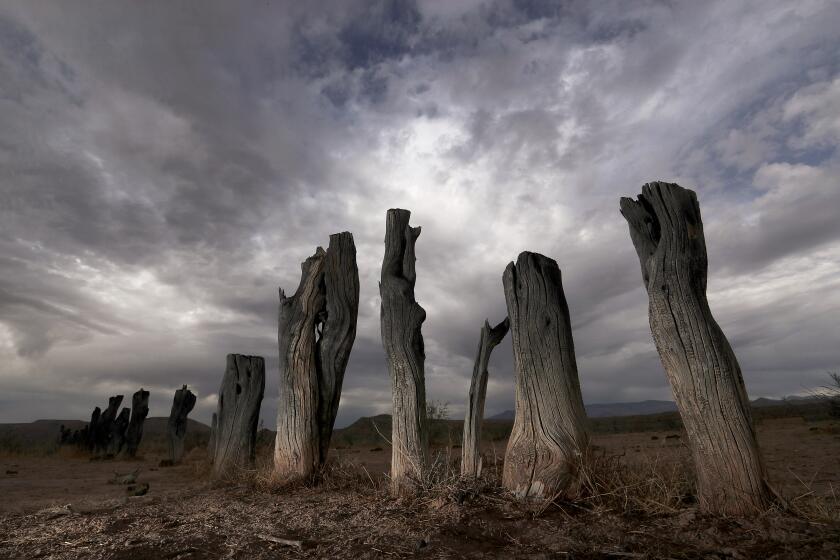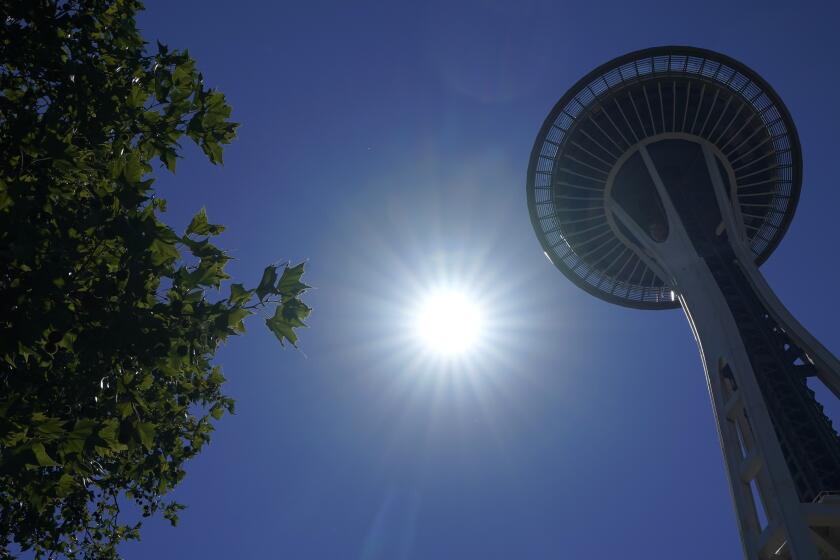Climate change is increasing the frequency and temperature of extreme heat waves

- Share via
As California awakens to the worsening risk of extreme climate events, researchers are shedding new light on last year’s anomalous and extreme Pacific Northwest heat wave. One study published this week said such heat waves could become 20 times more likely to occur if current carbon emissions continue unabated. Another said they may also be the equivalent of nearly 10 degrees Fahrenheit hotter.
The nine-day event in late June and early July 2021 seared parts of Northern California, Oregon, Washington and British Columbia, where Canada saw its highest temperature on record, 121.3 degrees. The heat wave claimed hundreds of lives, sparked several devastating wildfires and killed an estimated 1 billion sea creatures.
Such an event would have been “virtually impossible” in the 1950s, but atmospheric warming has already increased its probability to about a 0.5% chance per year, according to one study out of Columbia University, published Thursday in the journal Nature Climate Change. Should warming surpass 2 degrees Celsius — the upper limit set by the International Panel on Climate Change — that probability could soar to a 10% chance per year as soon as 2050.
“The single biggest control on how bad heat waves will get — in excess of how bad they already currently are — is the amount of CO2 that we put into the atmosphere,” said Samuel Bartusek, a doctoral student at Columbia’s Lamont-Doherty Earth Observatory and the lead author of the study. “There’s really only one solution to the problem of putting more carbon dioxide into the atmosphere, which is to stop doing it.”
Read all of our coverage about how California is neglecting the climate threat posed by extreme heat.
Bartusek said the extraordinary heat wave was “shocking” both for the people who experienced it and for the scientific community, which is why researchers hope to gain a better understanding of its physical mechanisms and its relationship to climate change.
“This was an extremely weird event,” said Michael Wehner, a climate scientist at the Lawrence Berkeley National Laboratory who co-authored another paper on the heat wave published last week in the journal Geophysical Research Letters. “It was also tragic, of course, because of the mortality that resulted from it.”
Among other conclusions, that paper found that the heat wave was so unprecedented it essentially broke most of the standard tools used to measure the human influence on heat waves.
“At the end of the day, we calculated not only was the event impossible without climate change — it was impossible with climate change. And of course, it happened, so that means that the model is wrong,” Wehner said.
Wehner said such statistical outliers make it difficult to forecast the future frequency of such events with certainty. However, his paper does include findings about temperature, noting that global warming caused an increase of as much as 1 degree Celsius in maximum temperatures during the heat wave.
Future warming could lead to an increase of 5 degrees Celsius in heatwave temperatures by the end of the 21st century, the paper says.
“The bottom line is that the amount of climate change we get is really determined by us, and by the people we elect to either mitigate emissions of carbon dioxide and other greenhouse gases or not,” he said. “And the less we do, the worse things get.”
The West is experiencing its most severe megadrought in a millennium, according to a new study. Scientists say climate change is playing a major role.
The Columbia researchers also found that several factors converged to help create the blistering heat dome, including anomalously dry soils and disruptions to the jet stream.
In California and other parts of the western United States, increasing heat, drought and aridification are contributing to long-term drying of soils, which means there’s less water to be evaporated into the air, Bartusek explained.
“And if there is less ability for evaporation to come out of the ground, there is a greater heating effect — where the air that’s just above the surface will be heated more effectively,” he said. He added that in some areas it’s likely there was “this feedback process going on where the land surface helped amplify some of the highest temperatures.”
The jet stream — the fast-flowing air currents in the upper level of the atmosphere that guide weather systems from west to east — also played a role in the heat wave, according to the study. Before and during the event, the jet stream “buckled” into a wave pattern and slowed down, essentially locking the weather system in place and allowing the dome of heat to build up over the region.
The researchers noted that the effect of climate change on the jet stream is still being debated, although some scientists believe such wave patterns are becoming more frequent and extreme due to human activity. Wehner said the question is “one of the most interesting problems in climate science right now.”
“It definitely remains a possibility that we would see more of these kinds of unusual flows with global warming,” he said.
Good morning. I’m Paul Thornton, and it is Saturday, July 3, 2021.
Kai Kornhuber, an adjunct associate research scientist at the Lamont-Doherty Earth Observatory and another of the Columbia study’s authors, said the findings highlight how deviations among soil moisture levels, the jet stream and other factors can drive temperatures even beyond their usual magnitudes.
“Sometimes these factors just align and you get those conditions that cause a perfect storm,” he said. “What is important to mention here, though, is that each of those drivers do exhibit increasing trends that are associated with climate change ... These types of coincidences might just occur with a higher likelihood in the future, just because these common drivers are all linked to climate trends.”
As for how likely it is that such heat waves will reach that yearly 10% probability by 2050, much depends on which emissions pathway society ends up taking. But “given the accelerated trends in extreme weather events globally, there are reasons to believe that these estimates might even be a bit conservative,” Kornhuber said.
He and the other researchers noted that while some of the studies’ numbers and predictions may differ, their key messages are very similar — that the extreme heat wave was essentially impossible at pre-industrial emission levels.
“What is important in this aspect is these methods all agree that climate change plays a major role in every heat wave that we observe nowadays,” Kornhuber said.
Though the findings are dire, the researchers said they could help inform future modeling of such events and help people to better prepare. Many parts of the Pacific Northwest were unequipped for such extreme heat, including homes without air conditioning and infrastructure systems unable to handle such strain. Wehner said improved adaptation efforts and contingency plans will help, but that ultimately, such events “are going to get worse because there’s a lot of climate change that’s baked into the system.”
“The more we can reduce our emissions — eventually getting down to none, to zero — and the sooner we can do that, the better in terms of avoiding even worse tragedies,” he said.
More to Read
Toward a more sustainable California
Get Boiling Point, our newsletter exploring climate change, energy and the environment, and become part of the conversation — and the solution.
You may occasionally receive promotional content from the Los Angeles Times.














